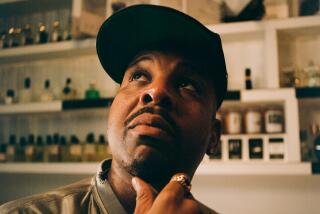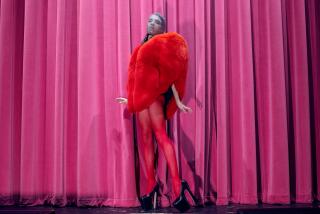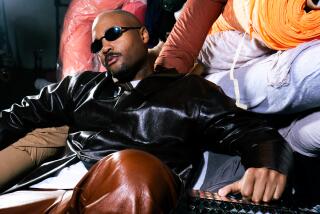Color Him Scentimental
COSTA MESA — Joachim Mensing is standing in the middle of the Nordstrom cosmetics department with buckets of paint and a canvas, but he’s no artist.
He’s a psychologist, and he’s not painting a picture, he’s dipping into people’s psyches.
Mensing, vice president of a German-based cosmetics company called the Lancaster Group, has long been fascinated with the way fragrances relate to moods, and the way moods relate to color. He’s come to Nordstrom at South Coast Plaza to launch his company’s new men’s cologne called Cool Water by conducting a “psychographic fragrance test” to see how color and fragrance influence feelings.
“We don’t just smell with our noses; we smell with our emotions,” Mensing says. “Whether someone likes a smell depends on their long-term memories linked to those smells.”
To prove his theory that fragrances can evoke certain moods, and that moods, in turn, relate to color, he has set up buckets of paint in a rainbow of shades and asked passersby to pick the two colors that best express how they feel.
There is no shortage of willing subjects: People love to learn about themselves, Mensing says.
“This test is not 100% serious. It’s a quick mood analysis,” he says.
Kim Jones of Diamond Bar approaches with her 14-year-old son Ryan. At Mensing’s urging, she points to buckets of powder blue and lavender. Mensing dips his brush in the paint and smears it on a canvas already covered with multicolored brush strokes. In his German accent, Mensing explains the meaning of the colors she has chosen.
“You didn’t choose something very outgoing. You chose something with a soft touch,” he says. “The lavender means you like to reflect on things. This pale blue is the color of space--you feel free, you don’t want to be restricted.” Jones laughs.
All the colors on Mensing’s palette correspond to a mood. Yellow is lively and optimistic. Red is dynamic--it’s for outgoing people who look for stimulation. The opposite of red is purple, for introspective types. Those who choose white are trying to conceal their emotions by picking no color.
“There’s a whole spectrum of myself I’m not showing when I pick white,” Mensing explains.
One woman in her 20s picks hunter green, the color of stability and inner harmony, and purple, the color of an introvert.
“What if I had chosen this lighter shade of purple?” she asks Mensing, pointing to the bucket of lavender paint.
“That’s more emotional,” he says.
“Ha! That’s my mother. She loves that color, and she’s extremely emotional.”
Then he squirts her wrist with Cool Water, a woodsy, herbal cologne, and asks her to pick the color that best expresses the scent.
She picks mint green. Mensing is not surprised. That’s how many people “see” the fragrance, he says.
In fact, by the end of the day Mensing has two canvases covered with paint that appear to prove his theories. The canvas that reflects people’s moods before they smell the fragrance has a predominant amount of red and black. The canvas painted after customers have had a whiff of Cool Water is covered primarily in cool shades of sky blue and green.
“No one sees it as an extremely powerful scent, so no one chooses black or red,” he says. The lighter cool shades show it’s an outgoing, woodsy fragrance.
Mensing has made a living advising his company on how fragrances should be packaged based on color and mood studies.
“I studied to be a psychologist, but I was always fascinated by the sense of smell, by what makes people choose fragrances,” he says.
As a student, he would conduct tests to see the relationship of fragrance to personality. He would ask participants to take personality tests and blindly choose from different fragrance families.
People who described themselves as extroverts preferred fresher, herbal fragrances, while introverts had an affinity for floral and oriental scents. He also found those same introverts liked deep colors such as blue and violet, while extroverts liked yellows and reds.
Ten years ago his work with fragrance led to the cosmetics industry instead of the analyst’s couch.
“I wanted to work with scents,” he says. He was hired by the Lancaster Group to use his background in psychology and sociology to give the company ideas about packaging a fragrance--a critical part of the competitive fragrance industry.
“I could look at a fragrance and say, ‘Change the box,’ ” he says.
For example, one wouldn’t put a woodsy scent in a red package, just as a spicy oriental fragrance doesn’t belong in a blue box.
“The fragrance must fit the bottle, the name and the color of the packaging,” Mensing says.
Not surprisingly, Cool Water comes in a blue bottle and a blue box.
“We could never package it in red,” Mensing says.






